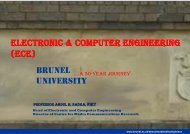DEliverable 2.3 - the School of Engineering and Design - Brunel ...
DEliverable 2.3 - the School of Engineering and Design - Brunel ...
DEliverable 2.3 - the School of Engineering and Design - Brunel ...
Create successful ePaper yourself
Turn your PDF publications into a flip-book with our unique Google optimized e-Paper software.
ICT Project 3D VIVANT– Deliverable <strong>2.3</strong><br />
Contract no.:<br />
248420<br />
User Acceptance Validation Plan<br />
context are useful for collecting summary data, such as user data (e.g., age, background), user<br />
satisfaction, ease <strong>of</strong> use <strong>of</strong> specific tasks, performance <strong>of</strong> <strong>the</strong> system, etc. This can be collected in<br />
a fairly quick manner <strong>and</strong> processed <strong>and</strong> analysed at a later stage. Questionnaires will be given to<br />
<strong>the</strong> users to complete during tests or after <strong>the</strong>y have used <strong>the</strong> tools in question.<br />
• Interviews – Semi-structured (prepared <strong>and</strong> spontaneous questions) interviews comprising <strong>of</strong> a<br />
selected user sample <strong>and</strong> one/two interviewees. The main aim here is to gain a deeper insight into<br />
<strong>the</strong> user perception <strong>of</strong> <strong>the</strong> system. Interviews are very useful in this context, as <strong>the</strong>y facilitate<br />
confidentiality <strong>and</strong> allow users to express <strong>the</strong>ir views on <strong>the</strong> system. This is very useful from <strong>the</strong><br />
interviewer’s perspective too, as <strong>the</strong>y can fur<strong>the</strong>r probe topics <strong>of</strong> interest with <strong>the</strong> user <strong>and</strong><br />
ascertain valuable data that is very difficult to gain o<strong>the</strong>rwise (e.g., via questionnaires). These are<br />
also useful in getting so-called user stories <strong>of</strong> <strong>the</strong>ir experiences. Interviews provide testers with<br />
process data.<br />
• Focus groups – Composed <strong>of</strong> a small number <strong>of</strong> users <strong>and</strong> a moderator. These are particularly<br />
useful in <strong>the</strong> process <strong>of</strong> user perception <strong>and</strong> form one <strong>of</strong> <strong>the</strong> main ways <strong>of</strong> getting feedback from<br />
pr<strong>of</strong>essional users. They help to establish a feeling <strong>of</strong> group membership <strong>and</strong> provide a unique<br />
opportunity for users to express <strong>the</strong>ir views in an informal but informative manner. It is <strong>of</strong>ten <strong>the</strong><br />
case in user groups that one response from a user triggers ano<strong>the</strong>r question or response from o<strong>the</strong>r<br />
users or <strong>the</strong> moderator creating an iterative type <strong>of</strong> group interview/discussion. Focus groups<br />
provide evaluators with information on what users thought during tests <strong>and</strong> where it specifically<br />
did not match <strong>the</strong>ir expectations (process data). Inspiring <strong>and</strong> constructive remarks, especially<br />
from pr<strong>of</strong>essional users, on how to improve <strong>the</strong> situation under assessment can be ano<strong>the</strong>r very<br />
important outcome <strong>of</strong> a focus group discussion.<br />
The following sections will explain in details which methods will be used for which tests <strong>and</strong> why.<br />
2.2 QUALITY ASSESSMENT ON 3D VIDEO<br />
While <strong>the</strong>re are st<strong>and</strong>ardised objective methods for quality assessment <strong>of</strong> 2D video coding, display,<br />
etc., such as Perceptual Evaluation <strong>of</strong> Video Quality (PEVQ) <strong>and</strong> “Peak-Signal-to-Noise-Ratio”<br />
(PSNR), metrics for validating 2D video, <strong>the</strong>se cannot be easily transferred to 3D (Veit 2011).<br />
Although ITU-R has initiated discussions on ‘Digital three-dimensional (3D) TV broadcasting’ (ITU-<br />
R Question 128/6 (2008)), <strong>the</strong>re are no agreed st<strong>and</strong>ards for testing <strong>the</strong> perceived quality <strong>of</strong> 3D video,<br />
yet. Therefore, 3D VIVANT’s user validation tests will be inspired by st<strong>and</strong>ards on traditional<br />
validation scenarios on Quality <strong>of</strong> Experience <strong>of</strong> 2D video <strong>and</strong>/or TV as well as by tests performed in<br />
<strong>the</strong> course <strong>of</strong> recent research activities <strong>and</strong> currently proposed st<strong>and</strong>ards.<br />
ITU-R Recommendation BT.500, a st<strong>and</strong>ard which describes various methods <strong>of</strong> showing test<br />
footage <strong>and</strong> recording testers’ opinions will be a good starting point. The follow-up ITU-R BT.1438<br />
did a very first step for st<strong>and</strong>ardizing subjective tests <strong>of</strong> 3D video but leaves many questions<br />
unanswered. The viewing conditions during <strong>the</strong> envisaged tests will be largely based on <strong>the</strong>se<br />
recommendations <strong>and</strong> on Chen’s catalogue <strong>of</strong> subjective video quality assessment methodologies for<br />
3DTV (Chen 2010), but may have to be adapted to 3DVIVANT-specific aspects in some details. In<br />
addition, methods <strong>of</strong> quality assessment <strong>of</strong> 3D displays, 3D content, <strong>and</strong> 3D devices based on human<br />
factors, are being discussed in IEEE P3333, <strong>the</strong> draft St<strong>and</strong>ard for Test Procedures for Electric<br />
Energy Storage Equipment <strong>and</strong> Systems for Electric Power Systems Applications 1 , <strong>and</strong> may be<br />
considered in order to optimise <strong>the</strong> validation settings, if available at <strong>the</strong> time.<br />
Validating user acceptance will also have to involve comparison tests with o<strong>the</strong>r available<br />
technologies.<br />
1 For more details check http://st<strong>and</strong>ards.ieee.org/develop/project/3333.html<br />
01.09.11 9
















